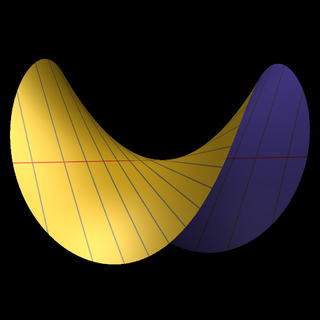
In mathematics and computer science, the floor function is the function that takes as input a real number and gives as output the greatest integer less than or equal to , denoted . Similarly, the ceiling function maps to the least integer greater than or equal to , denoted .

In topology, two continuous functions from one topological space to another are called homotopic if one can be "continuously deformed" into the other, such a deformation being called a homotopy between the two functions. A notable use of homotopy is the definition of homotopy groups and cohomotopy groups, important invariants in algebraic topology.
In mathematics, homotopy groups are used in algebraic topology to classify topological spaces. The first and simplest homotopy group is the fundamental group, which records information about loops in a space. Intuitively, homotopy groups record information about the basic shape, or holes, of a topological space.
In topology, a CW complex is a type of topological space introduced by J. H. C. Whitehead to meet the needs of homotopy theory. This class of spaces is broader and has some better categorical properties than simplicial complexes, but still retains a combinatorial nature that allows for computation.
In mathematics, in particular in homotopy theory within algebraic topology, the homotopy lifting property is a technical condition on a continuous function from a topological space E to another one, B. It is designed to support the picture of E "above" B by allowing a homotopy taking place in B to be moved "upstairs" to E.
In geometric topology, a field within mathematics, the obstruction to a homotopy equivalence of finite CW-complexes being a simple homotopy equivalence is its Whitehead torsion which is an element in the Whitehead group . These concepts are named after the mathematician J. H. C. Whitehead.
In mathematics algebraic L-theory is the K-theory of quadratic forms; the term was coined by C. T. C. Wall, with L being used as the letter after K. Algebraic L-theory, also known as 'hermitian K-theory', is important in surgery theory.
In mathematics, a pairing function is a process to uniquely encode two natural numbers into a single natural number.

In mathematics, blowing up or blowup is a type of geometric transformation which replaces a subspace of a given space with all the directions pointing out of that subspace. For example, the blowup of a point in a plane replaces the point with the projectivized tangent space at that point. The metaphor is that of zooming in on a photograph to enlarge part of the picture, rather than referring to an explosion.
In mathematics, in particular in algebraic topology, the Hopf invariant is a homotopy invariant of certain maps between spheres.

In mathematics, the Arf invariant of a nonsingular quadratic form over a field of characteristic 2 was defined by Turkish mathematician Cahit Arf (1941) when he started the systematic study of quadratic forms over arbitrary fields of characteristic 2. The Arf invariant is the substitute, in characteristic 2, for the discriminant for quadratic forms in characteristic not 2. Arf used his invariant, among others, in his endeavor to classify quadratic forms in characteristic 2.
In surgery theory, a branch of mathematics, the stable normal bundle of a differentiable manifold is an invariant which encodes the stable normal data. There are analogs for generalizations of manifold, notably PL-manifolds and topological manifolds. There is also an analogue in homotopy theory for Poincaré spaces, the Spivak spherical fibration, named after Michael Spivak.
In mathematics, the Kervaire invariant is an invariant of a framed -dimensional manifold that measures whether the manifold could be surgically converted into a sphere. This invariant evaluates to 0 if the manifold can be converted to a sphere, and 1 otherwise. This invariant was named after Michel Kervaire who built on work of Cahit Arf.
In the mathematical surgery theory the surgery exact sequence is the main technical tool to calculate the surgery structure set of a compact manifold in dimension . The surgery structure set of a compact -dimensional manifold is a pointed set which classifies -dimensional manifolds within the homotopy type of .
In geometric topology, a field within mathematics, the obstruction to a finitely dominated space X being homotopy-equivalent to a finite CW-complex is its Wall finiteness obstructionw(X) which is an element in the reduced zeroth algebraic K-theory of the integral group ring . It is named after the mathematician C. T. C. Wall.
In mathematics, more specifically in homotopy theory, a simplicial presheaf is a presheaf on a site taking values in simplicial sets. Equivalently, a simplicial presheaf is a simplicial object in the category of presheaves on a site. The notion was introduced by A. Joyal in the 1970s. Similarly, a simplicial sheaf on a site is a simplicial object in the category of sheaves on the site.
In algebra, Quillen's Q-construction associates to an exact category an algebraic K-theory. More precisely, given an exact category C, the construction creates a topological space so that is the Grothendieck group of C and, when C is the category of finitely generated projective modules over a ring R, for , is the i-th K-group of R in the classical sense. One puts
This is a glossary of properties and concepts in algebraic topology in mathematics.










































